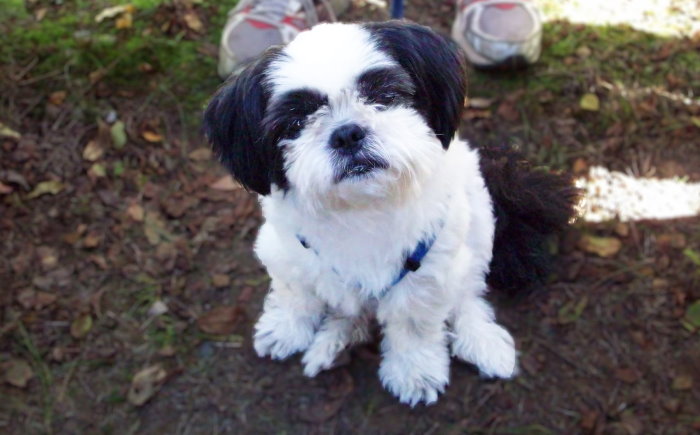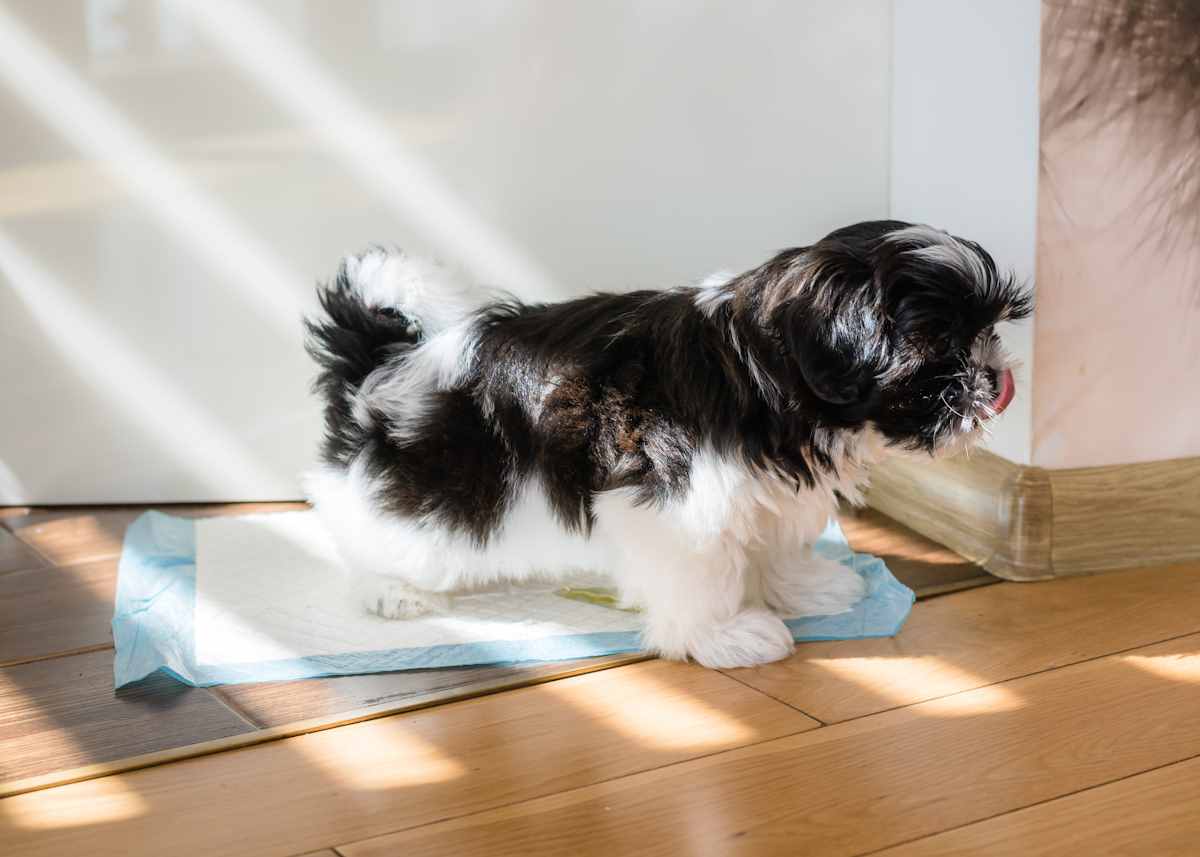Training Your Shih Tzu: Six Tricks A Shih Tzu Can Learn
AUGUST 12, 2019 | WRITTEN BY STACY

Shih Tzu possess quite a stubborn streak, and this gives them a reputation for not being the easiest breed of dog to train.
However, teaching your Shih Tzu a few tricks is not impossible, and it can actually be a fun and rewarding experience for both you and your pup.
You just need to take the time to know what to do, have patience and perseverance, and be realistic with the tricks you want to teach your dog.
Shih Tzu can be stubborn, but they can still be taught.
When it comes to teaching your Shih Tzu some tricks, it's best to start with these six basics; “sit”, “stay”, “come”, “settle”, “leave it”, and “heel.”
These tricks can best serve you and your pup because they help your dog be better behaved and happier.
Once your Shih Tzu has mastered the basics, you can add in some fun tricks like “shake”, “high five” and even “dance”.
Training your Shih Tzu doesn’t have to be stressful.
It can actually be a great way for you and your furry pal to bond.
The most important thing to remember is to stay consistent and calm -- if you’re stressed or nervous, your dog will pick up on this in a heartbeat and your training session will be a waste.
Of course, you also need to know how to train your pup, so take some time to read through this blog for helpful tips and why training your Shih Tzu is worth it.
Six Tricks to Teach Your Shih Tzu
Focus on the basics when it comes to teaching your Shih Tzu tricks.
Commands like “sit”, “stay”, “leave it”, “come”, “heel”, and “settle” help to keep your dog under control, safe and relaxed -- it makes things less stressful for you, too.
It is helpful to use a hand signal along with the command so that your dog associates the action with both verbal and non-verbal cues.
This comes in handy if you are in a situation where your dog may not be able to hear you. In fact, starting with the hand signal and adding the word after can be a good way to teach commands.
The first trick that most people start with is the basic sit command because it is usually the base position for most other commands, and then other tricks can follow.
Sit
The sit command is useful to keep your dog from jumping up on other people and to help your dog remain calm.
Hold a treat between your thumb and forefinger with your palm facing up, and place it in front of your Shih Tzu’s nose so she sees it.
Then move your hand slowly over her head, towards her tail.
Once her bottom hits the ground, give her positive praise and a treat. Once she is consistent with her sitting, try the hand signal without holding the treat, then add in the “sit” command.
Stay
The key with the stay command is to increase time increments little by little.
Have your dog begin in the sitting position and hold your palm in front of him, like a stop signal, eventually adding in the “stay” command.
Once your dog stays still for one second, praise and reward.
If your dog moves before you release her from the position, then start again.
Once the one-second stay is consistent, then continue with additional time - five seconds, 10 seconds and so on, until your Shih Tzu can consistently stay for 30 seconds.
Now, practice the stay command and increase the distance between you and your pup, again in increments, like one step, then two steps, then five, etc.
Once your pup is staying consistently at 10 steps, start combining time and distance, for example, one step and five seconds.
Then work in distractions, such as tossing a ball or having someone enter the room, always rewarding the desired behavior (your dog continuing to stay) with praise and a treat.
Come
The important thing about the come command is that it could very well be the command that saves your dog’s life one day, so always keep the cue positive.
Remember, you want your dog to come to you, so this command should make your dog feel like you’re about to do something really fun.
The reward for this command should be something your dog can absolutely not resist.
When working with your dog on the come command, if he tries to run from you, don’t chase him. He’ll think you’re playing a game and he’ll keep running from you.
The best option is to run away from him and keep your voice positive so that he runs toward you.
Have a squeaker toy, wave your arms and crouch down and be upbeat. As soon as your dog comes to you give him his prize and LOTS of praise.
Once he is coming to you consistently, add in the sit command when he reaches you before you give him his reward.
Settle (or Down)
Start your dog off in a sitting position, and then hold a treat in front of your dog’s nose.
Once she is focused on the treat, move it slowly toward the floor. As her head lowers to the ground, pull the treat slowly towards you so she extends her body and ends up in a lying down position.
As soon as her chest touches the floor give her praise and a treat to reward the desired behavior. If her bottom lifts off of the ground, then restart.
Again, once she is consistent, try with just the hand signal, and then add in the command, either “down” or “settle.”
Leave It
This command is also one that can save your dog’s life because it can keep her from eating something that she shouldn’t.
The key here is to use two different rewards - one that is super enticing for your pup and one that is not as exciting, maybe a piece of dog food.
This low-value reward will be the “leave it” item, and your pup should NEVER get this item.
Place the low-value item in your hand and give the command to “leave it.” If your dog goes for it, simply cover it with your hand.
As soon as your dog looks away from the low-value item, praise and reward with the enticing treat.
Once he is consistent, up the ante by placing the leave it item on the floor. (You can cover it with your foot).
Heel (Leash Training)
Make your walks with your dog more pleasant by teaching the “heel’ command, which basically teaches your dog to walk beside you and not pull on his leash.
Have your dog begin in the sitting position, and then say “heel” and begin walking.
If your dog passes you, stop and start again.
Throughout the walk, remember to periodically reward good behavior and give lots of praise whenever your dog is walking next to you.
These are the basic commands that you can teach your pup. Remember, every dog is capable of learning, it just takes patience and determination and consistency.
Once your dog gets the hang of the basics, you can try out some tricks for fun, such as shake, high five and dance.
There are a wide range of books and resources available that walk you through the steps of teaching specific tricks to your pup, and you can also take group obedience classes where a trainer demonstrates how to teach a specific trick and you are able to practice under the guidance of a professional.
If you want to hire a private trainer, that is a different situation -- more on this later.
Tips for Training Your Shih Tzu
It’s already been mentioned that Shih Tzu can be a challenging breed to train, but don’t confuse a challenge with an impossibility.
The critical element here is not how, but when you start training.
Whenever possible, it is best to start training your pup as soon as you can, and preferably when your dog is still a puppy - not necessarily because a puppy is easier to train, but because it’s less time she has to pick up bad behaviors. (More on training older dogs, later.)
This is mainly because the sooner you start, the sooner your dog knows how he is expected to behave and can act accordingly.
This translates to a lot less chewed up furniture and slippers for you, not to mention fewer potty accidents to clean.
Here are five essential tips to consider when it comes to training your Shih Tzu:
- Lay Down the Law -- Take a moment to think about what it was like the first day of a new school year.
You were in a new classroom, with a new teacher, and things were different.
If your teacher had any hope of surviving a class of energetic students, then she established rules on day one. If you don’t set rules and expectations, then people (and pups) don’t know what you want them to do.
You need to decide from the beginning what the rules will be for your dog -- will he get to sleep with you in your bed? Will he get to sit on the sofa? Are there certain rooms that will be off-limits? - Potty Training is a Priority -- Your small Shih Tzu has an equally small bladder, and you don’t want her emptying it on your carpet. Kick off the morning with a walk or trip outside for a potty break.
Whether you think your dog needs to go to the potty or not, take her outside frequently, and watch her carefully in between outside trips.
Every time she goes potty outside give her praise and a reward to reinforce the desired behavior. (You’ll be doing the same thing when you start teaching her tricks).
It’s important that your dog knows right from the start that one of the rules is -- she goes potty outside. - Be Prepared -- Before you begin your training sessions, gather your supplies.
For the most part, these will be small, bite-sized treats that you can use as rewards when your pup obeys a command.
If you will be leash training your Shih Tzu, then make sure you have properly fitted her ahead of time for a comfortable harness -- Shih Tzu should avoid collars because of their susceptibility to issues with their trachea and throat. - Don’t Encourage All-Day Dining -- It is best to have set feeding times for your pup, as opposed to leaving a dish of food down all day long for her.
If you leave food down all of the time, this encourages your dog to overeat, which of course, is not very healthy.
Plus, if your dog is used to an unlimited food supply, then she won’t be as encouraged by your edible rewards during your training sessions.
Having an established feeding schedule will also make housetraining a lot easier for you and your pup. - The Power of Praise -- Shih Tzu love attention and they love to please their owners. When you work with your Shih Tzu, focus on rewarding good behaviors, as opposed to punishing bad behaviors.
Offer praise when your dog does what you command and only use your Shih Tzu’s name in association with positive reinforcement.
In addition to praise throughout your training sessions, end each session with a lot of praise and rewards for your pup.
You want your dog to associate training sessions with good thoughts and pleasant experiences so that they will want to participate in future lessons.

Training an Older Shih Tzu
Ignore the old saying, “You can’t teach an old dog new tricks,” because it just isn’t true.
An older dog can learn just fine, and sometimes can even be easier to teach than a puppy.
So, if you adopt an older dog, have no fear, it’s possible to train your senior Shih Tzu. Basically, you teach an older dog with similar techniques that you would use for a puppy.
Your older pup might not care very much about the treats, but that is okay, be consistent with your praise and keep repeating the sessions.
It will most likely take a few short, daily training sessions for three to four weeks before the trick sticks with your Shih Tzu.
The Benefits of Training for Your Shih Tzu
A trained dog is a happy dog.
Obedience training has a number of benefits for your Shih Tzu, and for you, too.
When your dog listens and is well-behaved, the amount of stress you feel as an owner is significantly reduced.
You can take your dog on a walk without having to worry about what she is going to do if you pass another dog, or a person on a bike, or any other situation that could potentially excite a dog.
You can do more together with your dog when your dog is trained, for example, enjoy an outdoor sitting area at a dog-friendly restaurant, play with your dog at the local dog park or even let your dog participate in different community programs, such as “Reading to Rover” style events at your local library.
In addition to these benefits, training does so much more for you and your pup, such as:
- Better Control
When your Shih Tzu is trained in basic commands, she is easier to control, even when encountering different situations that could otherwise stress out your pup.
Training helps your dog remain calm when she meets new people and other animals, and also makes it more pleasant when you have visitors to your home.
- Safety First
Picture this situation: your dog is walking with you and gets startled. She bolts so quickly that the leash is yanked out of your hand and she starts to run. You see that she is running directly into the path of an oncoming car, and you call her name, which stops in her tracks.
Then, you tell her to come, and she runs back to you.
If your dog was not trained, this situation would have a very different, and most likely very unhappy ending.
Training your dog can legitimately save her life.
- Bonding Time
When you work with your dog during training sessions you will start to notice a lot more about how your dog reacts to different stimuli, and you will start to pick up on all of your dog’s unique quirks and her personality.
Training also helps to establish you as the one in charge.
All of these different factors add up to some incredible bonding opportunities for you and your pup.
When you and your dog spend more time together, you understand each other more, and this helps to build a relaxed and strong relationship between the two of you.
- Banish Boredom
Shih Tzu love to play, and there is no reason why a training session can’t be disguised as one big bout of play time fun for you and your canine pal.
Shih Tzu need a lot of attention, otherwise they can get up to mischief.
Training and the interaction with you that training provides, offers your Shih Tzu much needed stimulation that can keep her amused, engaged and out of trouble.
Should You Get a Professional Trainer?
Training your own dog can be an incredible experience, but it can also be incredibly frustrating if you do not know what you are doing.
That is why it is so important to educate yourself and be prepared before you begin.
Patience is key! If you are not a patient person, then training your own pup is probably not the best idea.
However, if you think your personality is up for the challenge, then you can enroll you and your pup in a group training class where you get to work with your pup under the guidance of a pro, and then you practice your “homework” with your pup on your own time.
If training your Shih Tzu is just not working out for you though, you might consider hiring a professional private trainer to work with your dog.
This can be the best way for you to train your pup, but there are some things you need to think about first.
Not all trainers are the same; different trainers use different methods and have different philosophies about training.
Make sure that the trainer you choose aligns with your own beliefs about how your dog should be trained, for example, through rewarding positive behavior.
There are different types of trainers, such as those that work with agility training, trainers that work with dogs to teach them specific jobs (like herding, hunting, etc.) and of course behavioral and obedience training.
The latter is the type of trainer you will most likely search for in order to teach your dog the basics.
If you do decide to hire a professional trainer to work with your pup, then make sure to do your due diligence first.
Before hiring anyone, sit down with him and have a chat. You want to make sure that the trainer’s personality is a good fit for you and your dog, and you want to get his answers to the following questions:
- How long have you been a trainer?
- What techniques do you use to train dogs? How do you respond when a dog doesn’t give the desired behavior?
- Do you guarantee results? How long are your training sessions?
- What do you charge? Will there be extra fees or supplies that I need to buy?
- Do you work with Shih Tzu often?
- What do you do if my dog gets stressed during a session?
Hopefully these tips will get you started on the right track when it comes to teaching your Shih Tzu basic commands and training your Shih Tzu.
For more fun facts and resources to help you get the most out of your time with your Shih Tzu, make sure to check out the rest of our blog!
We wish you many happy training sessions with your furry friend!




